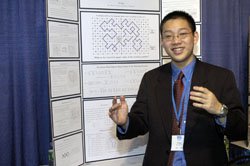In a one-dimensional random walk, a “walker” is confined to a long, narrow path and moves forward or backward in steps according to the results of repeatedly tossing a coin. The walker takes a step in one direction if the outcome is heads and in the opposite direction if the outcome is tails.

For a walk along an infinite track, you can calculate a walker’s long-term behavior. The resulting trail wanders back and forth along the track, and the probability of the wanderer’s being a certain distance away from the starting point after taking a given number of steps is defined by the bell-shaped curve known as a Gaussian distribution.
One consequence of this type of erratic movement back and forth is that a random walker is certain to return to its starting point—eventually.
In two dimensions, a walker can take steps east, west, north, or south, randomly choosing a direction with equal probability. It’s like going from vertex to vertex on an infinite checkerboard grid. If such a walk continues for an arbitrarily long time, the walker is certain to touch every vertex. This includes the case of returning to the starting point.
For his Intel Science Talent Search math project, Yi Sun of the The Harker School in San Jose, Calif., worked out the expected number of steps it takes a walker on a two-dimensional grid to encircle a given point (origin). One such circuit corresponds to a winding number of 1.
Yi discovered that the expected number of steps to complete such a circuit in two dimensions is infinite. He also derived an explicit (very complicated) formula for the expected value of the winding number after n steps.
Yi says that his result has applications to modeling polymer behavior around a rod and may lead to a deeper understanding of the structure and properties of random walks.
For his efforts, Yi won second place in the 2006 STS competition for high school seniors.
Check out Ivars Peterson’s MathTrek blog at http://blog.sciencenews.org/.






